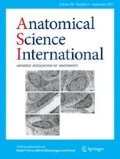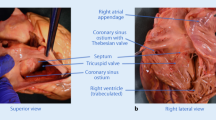Abstract
We herein report a case showing the simultaneous occurrence of an aberrant right subclavian artery (ARSA) and accessory lobe of the liver in a 75-year-old female cadaver. In the thorax, the left aortic arch branched into the right common carotid artery, left common carotid artery, left subclavian artery, and ARSA, in that order. The ARSA was dilated at its origin to form Kommerell’s diverticulum and coursed behind the esophagus. This diverticulum seemed to press the esophagus. A right-sided thoracic duct was identified that emptied into the angulus venosus. In the right-sided neck, a nonrecurrent laryngeal nerve was found. In the abdominal cavity, an accessory lobe protruded from the anterior margin of the left liver lobe. The accessory lobe was separated from the left lobe by a transverse furrow on the anterior side. We discuss possible common causes of these anomalies during development.

Similar content being viewed by others
References
Baglaj SM, Czernik J (2004) Nitrofen-induced congenital diaphragmatic hernia in rat embryo: what model? J Pediatr Surg 39:24–30
Celis I, Vandendriessche L, Storme L, Peene P, Thywissen C, Vandekerkhof J (1996) Aortic coarctation associated with an aberrant right subclavian artery. J Belge Radiol 79:170–171
Chiba S, Suzuki T, Kasai T (1991) A tongue-like projection of the left lobe in human liver, accompanied with lienorenal venous shunt and intrahepatic arterial anastomosis. Okajimas Folia Anat Jpn 68:51–66
Ergun T, Lakadamyali H, Lakadamyali H, Eldem O (2008) Adult polysplenic syndrome accompanied by aberrant right subclavian artery and hemangioma in a cleft spleen: a case report. Ann Vasc Surg 22:579–581
Gittenberger-de Groot AC, Azhar M, Molin DG (2006) Transforming growth factor beta-SMAD2 signaling and aortic arch development. Trends Cardiovasc Med 16:1–6
Henry JF, Audiffret J, Denizot A, Plan M (1988) The nonrecurrent inferior laryngeal nerve: review of 33 cases, including two on the left side. Surgery 104:977–984
Komiyama M, Matsuno Y, Shimada Y (1995) Variation of the right subclavian artery as the last branch of the aortic arch in two Japanese cadavers. Okajimas Folia Anat Jpn 72:245–247
Lee PW, Ritter MJ, Quinonez LG, Glockner JF, Oh JK (2007) Aberrant right subclavian artery from an aneurysmal diverticulum of Kommerell in an 84-year-old man. Am J Cardiol 100:556–558
Millar A, Rostom A, Rasuli P, Saloojee N (2007) Upper gastrointestinal bleeding secondary to an aberrant right subclavian artery-esophageal fistula: a case report and review of the literature. Can J Gastroenterol 21:389–392
Raider L (1967) Aberrant right subclavian artery. South Med J 60:145–151
Sánchez A, Alvarez AM, Benito M, Fabregat I (1996) Apoptosis induced by transforming growth factor-beta in fetal hepatocyte primary cultures: involvement of reactive oxygen intermediates. J Biol Chem 271:7416–7422
Sato S, Watanabe M, Nagasawa S, Niigaki M, Sakai S, Akagi S (1998) Laparoscopic observations of congenital anomalies of the liver. Gastrointest Endosc 47:136–140
Ulger Z, Ozyürek AR, Levent E, Gürses D, Parlar A (2004) Arteria lusoria as a cause of dysphagia. Acta Cardiol 59:445–447
Watson JR, Lee RE (1964) Accessory lobe of the liver with infarction. Arch Surg 88:490–493
Yu J, Gonzalez S, Rodriguez JI, Diez-Pardo JA, Tovar JA (2001) Neural crest-derived defects in experimental congenital diaphragmatic hernia. Pediatr Surg Int 17:294–298
Zalel Y, Achiron R, Yagel S, Kivilevitch Z (2008) Fetal aberrant right subclavian artery in normal and Down syndrome fetuses. Ultrasound Obstet Gynecol 31:25–29
Zapata H, Edwards JE, Titus JL (1993) Aberrant right subclavian artery with left aortic arch: associated cardiac anomalies. Pediatr Cardiol 14:159–161
Author information
Authors and Affiliations
Corresponding author
Electronic supplementary material
Below is the link to the electronic supplementary material.
12565_2010_100_MOESM1_ESM.ppt
Supplementary Figure 1. In the right-sided neck, a nonrecurrent laryngeal nerve (black arrowhead) is found branching from the vagus nerve (white arrowhead) at the level of the seventh cervical vertebra. RC, right common carotid artery; RS, right subclavian artery; TR, trachea (PPT 274 kb)
12565_2010_100_MOESM2_ESM.ppt
Supplementary Figure 2. Photograph and line drawing of structures in the chest and neck in the anterior view, including the aberrant right subclavian artery (ARSA), nonrecurrent laryngeal nerve (arrow), and right-sided thoracic duct (TD). The proximal part of the aberrant right subclavian artery, nonrecurrent laryngeal nerve, and right-sided thoracic duct are hidden in the photograph, but shown based on the observation as dotted lines in the line drawing. In the posterior mediastinum the right-sided thoracic duct ascends between the descending thoracic aorta and the azygos vein, and lies posterior to the esophagus and anterior to the bodies of the thoracic vertebra. At the level of the fifth thoracic vertebral body, the thoracic duct moves to the right of the midline. Finally, it ascends to the thoracic inlet and ends by emptying into the junction of the right subclavian vein and right internal jugular vein. E, esophagus; H, heart with pericardium; LBV, left brachiocephalic vein; LCA, left common carotid artery; LJV, left internal jugular vein; LL, left lung; LSA, left subclavian artery; LSV, left subclavian vein; LVN, left vagus nerve; RCA, right common carotid artery; RJV, right internal jugular vein; RL, right lung; RSV, right subclavian vein; RVN, right vagus nerve; T, thyroid gland; TR, trachea. (PPT 1.61 mb)
12565_2010_100_MOESM3_ESM.ppt
Supplementary Figure 3. (a) Anterior view of the accessory lobe (AL). The accessory lobe measures 76 x 32 x 30 mm. The transverse furrow (black arrowhead) is 10 mm in depth. (b) Section of the left (L) and accessory lobes. The liver tissue is narrowed by the furrow but the accessory lobe is attached directly to the left lobe without fibrous connective tissue. Intrahepatic distributions of the portal triads (c) and hepatic veins (d). The portal triads distribute separately into the accessory lobe (white arrow) and inferior subsegment of the lateral segment (black arrow) from the lower branches of the lateral segment. Branches of the hepatic veins from these parts arise separately (white and black arrows) but are both drained into the left hepatic vein (HV). RL, round ligament of the liver. (PPT 673 kb)
Rights and permissions
About this article
Cite this article
Kaidoh, T., Inoué, T. Simultaneous occurrence of an aberrant right subclavian artery and accessory lobe of the liver. Anat Sci Int 86, 171–174 (2011). https://doi.org/10.1007/s12565-010-0100-8
Received:
Accepted:
Published:
Issue Date:
DOI: https://doi.org/10.1007/s12565-010-0100-8




